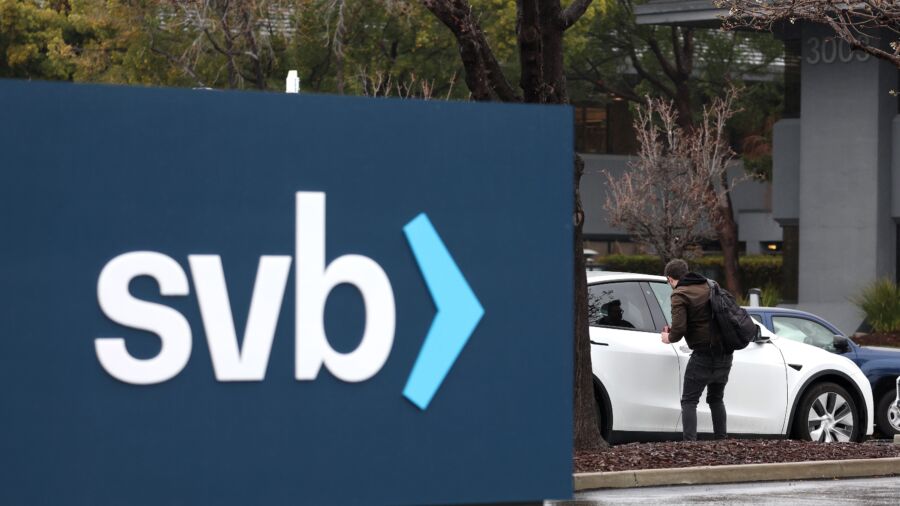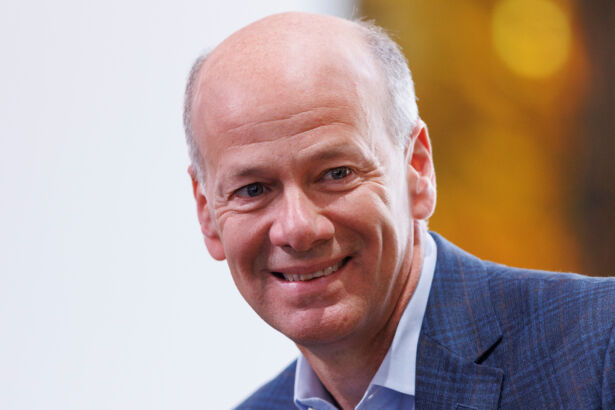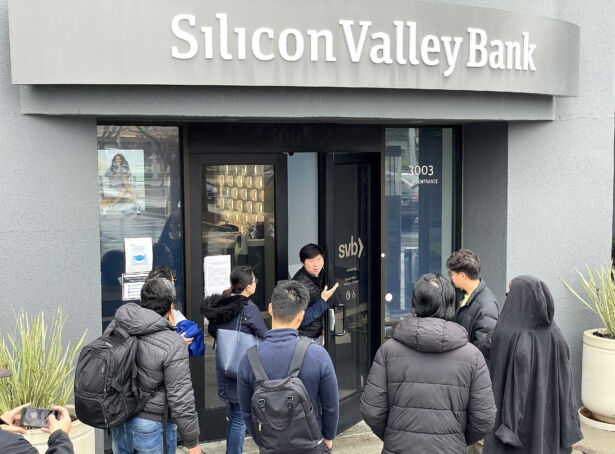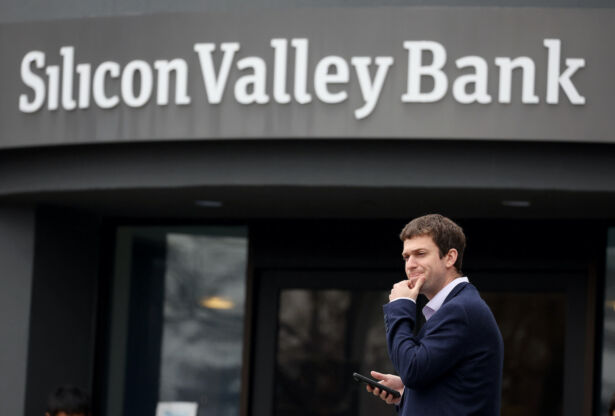BY THOMAS KIKA
Andrew Yang, a businessman and Democratic political candidate in multiple races, urged on Friday for government action on the collapse of Silicon Valley Bank (SVB), warning of potential mass layoffs and "financial contagion."
SVB on Friday began to collapse in the face of a sudden run on its sizeable deposits. While largely unknown to the broader United States, SVB was a go-to financial institution for startup businesses in California's Silicon Valley tech corridor, with over $200 billion in assets by the end of last year, according to CNN. Its ongoing troubles make it the most significant U.S. bank failure since Washington Mutual in 2008.
Following a career at various businesses, Yang rose to national prominence as a candidate for the Democratic presidential nomination in 2020, where he most notably advocated for universal basic income. That campaign ultimately failed, as did a 2021 run for mayor of New York City. Yang has since changed his party affiliation to independent and co-founded the centrist Forward Party.
In response to SVB's collapse on Friday, Yang urged in a Twitter thread that either the California government or the U.S. Treasury Department should intervene to help the ailing institution and prevent various calamities that might emerge due to its failure.
"I think either California or the Treasury Department should backstop Silicon Valley Bank - thousands of companies will fold or lay people off next week because of lack of access to accounts through no fault of their own," Yang wrote. "Take the equity and fire the managers. But SVB's clients - many biotech - are important for national innovation and competitiveness. Plus you need to instill trust and reduce financial contagion/panic/further runs."
Yang further insisted that the government entities take control of SVB's equity and fire its management teams, adding that "there's a big difference between irresponsible bank managers and the thousands of customers and entrepreneurs and employees who chose to use a bank that was one of the biggest banks in the country."
In a piece for Bloomberg on Friday, finance columnist Matt Levine argued that recently raised interest rates prompted many of SVB's customers to withdraw their deposits en masse, forcing the bank in turn to sell its securities at a loss in order to give them their money back. Rates were hiked by the Federal Reserve as part of a plan to combat rising inflation rates.
"Now [SVB has] lost money and [looks] financially shaky, so customers get spooked and withdraw more money," Levine wrote. "So you sell more securities, so you book more losses, oops oops oops."
Newsweek reached out to California Governor Gavin Newsom's office and the U.S. Treasury Department via email for comment.
Robert Hockett
Contributor
I cover law, justice, money, finance and economics.
Mar 11, 2023

THE NEW DEAL LEGISLATION WAS ENACTED AT GREAT SPEED. AS SOON AS THE SPECIAL SESSION OF CONGRESS ... [+]BETTMANN ARCHIVE
Something must be wrong with me. Suspicious of large banking houses nearly since youth, I am now finding it difficult to fault Silicon Valley Bank’s (SVB’sVB +1.7%) management or depositors as relevant culprits in the second-largest bank failure in history yesterday. Worse yet, I am now wondering why we do not deposit-insure all bank deposits, in return for insurance premia and capital-regulatory compliance, of course – for their full amounts, not merely $250K per deposit, as we do now.
Please hear me out.
Any banking expert, especially any such expert who was around back in 2008, will tell you that the holy grail of any financial system is that there be at least one class of ‘boring’ financial institution to serve as safe haven for non-financiers to park savings, cash, or working-capital. The image of any such safe haven institution implies certain qualities on the parts of (a) typical depositors and (b) typical bank investment portfolios.
The typical depositor in such an institution is someone who isn’t gambling on price movements in secondary financial or tertiary derivatives markets, but is aiming instead to introduce and produce new product lines or services in primary markets – contributions to the ‘real economy’ that improve our material lives over time. Such ‘makers’ are producing, not ‘taking’ or speculating, and accordingly need repositories in which to hold ‘patient capital’ as their businesses get underway.
These repositories, for their part, must also refrain from mere gambling activity with depositors’ funds. They must instead prudently invest in actuarially sound business loans in the productive sectors on the one hand, while investing any additional holdings in safe, readily liquidated assets on the other hand. Where the latter are concerned, US Treasurys are (almost literally) the gold standard, the safest of the safe and the most liquid of the liquid – so much so, in fact, that they are accounted ‘near-moneys’ deserving of literally zero risk-weightings in all systems of risk-based capital regulation.
SVB’s portfolio, for its part, appears also to have been precisely what we should want to see – prudently evaluated loans to this same tech clientele on the one hand, none of which were in trouble, imparting to SVB something of the flavor of a tech credit union – and US Treasurys – safest of safe assets – on the other hand. This portfolio (which largely replicates the Fed’s under QE), along with the bank’s deposit base, unsurprisingly took a hit as Jay Powell’s Fed, misdiagnosing the cause of our macro-economy’s recent CPI inflation (it is supply- and profiteering-driven this time, not wage- or salary-driven), began raising interest rates with greater abruptness than at any time in the last 45 years (an astounding 450 basis points in a year).



This was effectively force majeure where SVB was concerned, and the only errors that the bank seems to have committed were (a) not to have hedged against virtually unforeseeable interest rate risk, and (b) to have sold off some of its Treasurys and offered a new issuance of convertible bonds to the market in order to handle the squeeze between ultimately Fed-induced depositor losses and consequent withdrawal needs on the one hand and Fed-induced portfolio losses on the other hand.
That was like blood in the water for incompletely insured depositors and short-sellers alike, inducing a classic self-fulfilling-prophecy style bank run.
But this feature of this bank run – its character as self-fulfilling prophecy, or what I long ago dubbed a recursive collective action problem – tells us precisely where we ought to focus our public response. SVB was not, and is not, fundamentally insolvent. Its crisis is literally none but a fear-induced liquidity crisis – a crisis that would not occur were all deposits fully insured, as FDR well understood when declaring our nation’s first ever ‘bank holiday’ in early 1933 till a then-brand-new system of federal deposit insurance could be fashioned post haste.
What FDR saw was that the solution to a recursive collective action problem is an exercise of collective agency – in this case, a public action that removes the source of individually rational but unnecessary fears that aggregate into collectively irrational outcomes. That’s all that deposit insurance is. But to optimize it we must make it applicable to literally all relevant cases – all cases where only short-term liquidity, not mid-term or long-term solvency, is in question.
The time has accordingly come for a 2023 equivalent, almost 90 years to the day, of FDR’s 1933 bank holiday and rapid response insurance move: the President and Congress should immediately extend FDIC coverage to all sound bank deposits, in their full amounts. There is literally no reason not to do this. For again, SVB was not and is not actually insolvent – its trouble was all self-fulfilling prophecy. And banks that receive deposit insurance have to pay premia and comply with safety and soundness requirements already – just as do any policyholders in any insurance industry. Why not, then, recognize current FDIC limits for the anachronism they are and update them?
When a bank does literally near everything that we have wished safe banks to do, and when its depositors are literally the very production-focused entrepreneurs we want all entrepreneurs to be, it is perverse to allow them – and our nation’s single most dynamic and productive industrial sector – to be penalized by no more than self-fulfillingly prophetic fear. Where fundamentals are genuinely sound and risk-taking is genuinely entrepreneurial in the primary, not secondary or tertiary market sense of the word, our safe havens ought to be guaranteed safe. And that goes for de facto credit unions as much as for commercial banks.
But it doesn’t rule out bona fide productive entrepreneurial activity. Yes, SVB’s depositors might have done well to broker their deposits to assure greater insurance coverage and yes, SVB might have done well to enable and encourage that. But in the grand scheme of our now urgently re-industrializing national economy, those were but rookie mistakes at worst, rendered all the more possible by a now catastrophically wrong-headed Fed.
And when we remember that tech firms, like other firms that we want to emerge in a plethora of new sectors as we now turn to re-industrializing our economy, have large operating budgets for which $250K transaction accounts are simply to small, it grows doubtful these even were ‘mistakes.’ If anything, we should probably be grateful that a ‘new, old’ breed of sector-specific, Main Street industrial banks seem to be coming back - far better that our new ‘makers’ use these than use ‘shadow banking’ options or one-size-fits-all, ‘Big Five’ Wall Street banks.
The sensible solution to SVB’s troubles and those of its peers, then, seems obvious: Insure all deposits that are compliant with FDIC soundness requirements, now and forever. Risk-price the premia and segment accounts by size, assessing reasonable surcharges against the bigger ones for the insurance. And please, stay Powell’s crazed rate-raising hand as we turn to the real drivers of our current inflation – severe underproduction and associated price-gouging by sociopathic corporate executives
Robert Hockett
I teach legal, financial and some philosophical subjects at Cornell University in New York, where I am the Edward Cornell Professor of Law and a Professor of Public Policy. I also am Senior Counsel at Westwood Capital, a socially responsible investment bank in midtown Manhattan, and a Fellow of The Century Foundation, a think tank near Battery Park in lower Manhattan. My principal research, writing, and practical concerns are with the legal and institutional prerequisites to a just, prosperous, and sustainable economic order. I have worked at the International Monetary Fund and the Federal Reserve Bank of New York, and continue to serve in a consultative capacity for a number of U.S. federal, state, and local legislators and regulators. I grew up mainly in New Orleans, America's most wonderful city (sorry, New York), and return to it often. I was educated at Yale, Oxford (as a Rhodes Scholar), and the University of Kansas.
SVB Chief Sold $3.6 Million in Stock Shortly Before Bank’s Collapse

Documents show that the CEO of Silicon Valley Bank (SVB) sold $3.6 million in shares of the failed financial institution’s parent company several weeks before its collapse—the biggest U.S. bank failure since 2008 that sent a shudder of anxiety across markets.
A filing with the Securities and Exchange Commission (SEC) shows that Greg Becker, who joined SVB as a loan officer three decades ago before becoming CEO about a decade later, sold 12,451 shares of the bank’s parent company SVB Financial Group on Feb. 27.
Becker sold the shares in accordance with a trading plan filed on Jan. 26, a little over a month before the group sent a letter to stakeholders (pdf) saying it was looking to raise over $2 billion in capital after taking losses.
An inquiry sent to SVB outside of normal working hours asking whether Becker was aware of the bank’s plans to try and raise capital was not immediately returned.

“Lots of chatter today about the possibility of generalized U.S. banking system stress due to SVB troubles. Three summary things on this: While the U.S. banking system as a whole is solid, and it is, that does not mean that every bank is,” stated economist Mohamed A. El-Erian in a tweet.

SVB Collapses, FDIC Steps In
SVB failed on March 10, just days after the bank sent the notification signaling its scramble to raise capital after reporting a $1.8 billion loss after being forced to sell Treasury bonds to meet its deposit obligations.
California regulators ordered the bank shut and appointed the Federal Deposit Insurance Corporation (FDIC) as receiver.
The FDIC, which has a mandate to protect depositors in case of bank failure and insure their deposits up to a coverage limit of $250,000, said in a statement that all insured depositors will have full access to their covered deposits by March 13.
SVB had approximately $209.0 billion in total assets and roughly $175.4 billion in total deposits as of Dec. 31, according to the FDIC.
“At the time of closing, the amount of deposits in excess of the insurance limits was undetermined,” the FDIC said. “The amount of uninsured deposits will be determined once the FDIC obtains additional information from the bank and customers.”
As of the end of 2022, SVB had around 89 percent of its $175 billion in deposits that were uninsured.

SVB is the largest bank to fail since the 2008 financial crisis when Washington Mutual collapsed.
Sheila Bair, who helmed the FDIC during the global financial crisis, told Reuters in an interview that bank regulators are likely now turning their attention to other banks that may have high amounts of uninsured deposits and unrealized losses, two factors that contributed to SVB‘s quick failure.
“These banks that have large amounts of institutional uninsured money … that’s going to be hot money that runs if there’s a sign of trouble,” Bair said.
The sequence of events that led to SVB‘s rapid collapse include it selling U.S. Treasuries to lock in funding costs due to expectations of higher interest rates.
Faced with persistently high inflation, the Federal Reserve has hiked interest rates rapidly and officials have warned of further tightening ahead.
US Banks ‘Generally in a Strong Financial Condition’
Several days before SVB failed, FDIC Chairman Martin Gruenberg warned bankers gathered in Washington that financial institutions face higher levels of unrealized losses, as the Fed’s rapid interest rate increases have driven down the value of longer-term securities.
“The good news about this issue is that banks are generally in a strong financial condition … On the other hand, unrealized losses weaken a bank’s future ability to meet unexpected liquidity needs,” Gruenberg said.
Gruenberg’s remarks came three days before SVB announced it was looking to raise capital.
The speed of the SVB crash stunned observers and blindsided markets, wiping out more than $100 billion in market value for U.S. banks in two days.
Several experts said any ripple effects in the rest of the banking sector are likely to be limited. Part of this is because bigger banks have more diverse portfolios and depositors than SVB, which was highly reliant on the startup sector.
“We do not believe there is contagion risk for the rest of the banking sector,” said David Trainer, CEO of New Constructs, an investment research firm.
“The deposit base from the major banks is much more diversified than SVB and the big banks are in good financial health,” he added.
SVB’s collapse could lead to calls for tougher regulation.
Reuters contributed to this report.




No comments:
Post a Comment